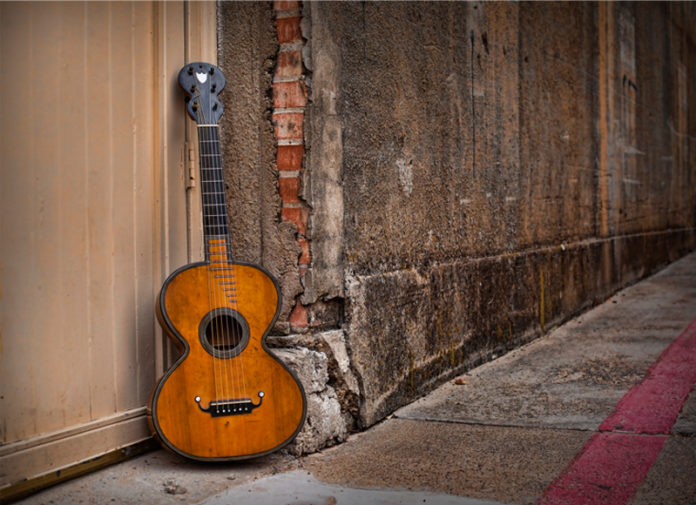by Chris Fritchie
“Hey Stephen, I have this idea. Can I borrow a couple of your guitars for a few days? ..Umm sure?”
…and so it began
It was the summer of 2010 and I had met Stephen Arnold a couple of years earlier when he interviewed me to be his VP of Sales. The position didn’t work out but we did have one thing in common… a love of guitars… and he had an incredibly unique collection in abundance of 50 of them. I was trying to simply come up with an idea that I could make a few bucks to help pay the bills. At that time, I had no idea that conversation would lead to the most epic, once in a lifetime project that would have me travelling the entire country off and on for the next year and a half.
Stephen Arnold is a legend and pioneer in the broadcast music world. He created the popular term called “sonic branding.” Do a search on YouTube for “Stephen Arnold The Weather Channel” and you’ll find an interview with Stephen who shares how sonic branding works. He has composed and produced music for thousands of television stations and every major network including CNN, ESPN, The Weather Channel, The Golf Channel and more. Today, his music is used globally to brand news broadcasts and networks from the U.S. to China, India and other countries. Countless millions of people hear his music daily. No doubt you’ve heard it, too. It’s estimated that over 1 billion people hear his music daily. He’s won Emmy’s, Addy’s and Promax Gold Awards.
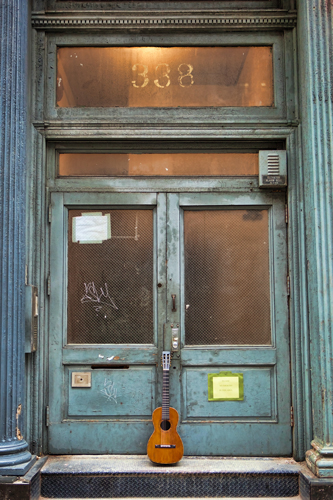 One of the two guitars I borrowed from Stephen was “Katrina.” It was a 1969 Fender Stratocaster that Stephen purchased in late July of 2005 while in New Orleans. This was about a month before hurricane Katrina destroyed the vintage music store and its contents. When I showed up at Stephens studio in McKinney, Texas, he handed me the guitar. He hadn’t really given the story of the guitar much thought. I quizzed him about it and he realized he had purchased it while doing sessions for WWL-TV. He kinda laughed and said, “I guess I saved that guitars life.” That was the day he named the guitar “Katrina.” The story also set off a hurricane of thoughts racing through my head on exactly what the project would be. The original idea was to simply create a coffee table book that Stephen could put in his office.
One of the two guitars I borrowed from Stephen was “Katrina.” It was a 1969 Fender Stratocaster that Stephen purchased in late July of 2005 while in New Orleans. This was about a month before hurricane Katrina destroyed the vintage music store and its contents. When I showed up at Stephens studio in McKinney, Texas, he handed me the guitar. He hadn’t really given the story of the guitar much thought. I quizzed him about it and he realized he had purchased it while doing sessions for WWL-TV. He kinda laughed and said, “I guess I saved that guitars life.” That was the day he named the guitar “Katrina.” The story also set off a hurricane of thoughts racing through my head on exactly what the project would be. The original idea was to simply create a coffee table book that Stephen could put in his office.
Over the next week I photographed the two guitars I borrowed from Stephen. The idea was simple. I wanted to tell the story of Stephen Arnold Music against the backdrop of Stephen’s unique guitar collection in various locations. It’s not that this was a collection of the most rare and expensive guitars, quite the opposite. The guitar collection was made up of unique guitars, some rare and some common. What was cool about them was they each had a voice, one that cried out to Stephen in a way he knew he had to use them to create a unique sound.
I photographed the two guitars and, instead of just showing him the digital files, I ordered two large prints of each guitar and made an appointment with Stephen. On the day of the next meeting I walked into his office, handed him the images and said, “Stephen, I want to create an album to tell your story.” His reply was, “When can you start?”
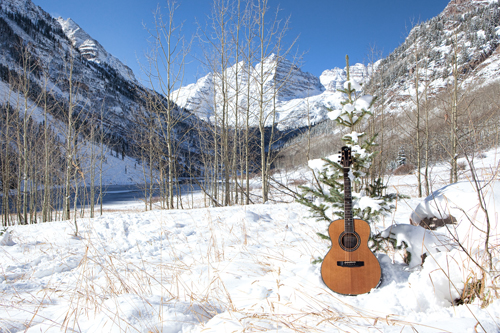 What happened over the next few weeks was mind blowing. Both of our creative minds went down the path of telling his story of how he left Dallas and went to Los Angeles to pursue a music career in the 60’s. We both knew we needed to shoot the guitars in places that helped tell the story of his life’s journey.
What happened over the next few weeks was mind blowing. Both of our creative minds went down the path of telling his story of how he left Dallas and went to Los Angeles to pursue a music career in the 60’s. We both knew we needed to shoot the guitars in places that helped tell the story of his life’s journey.
Over the next year and a half we would end up shooting guitars in crazy places all over the country. One of my favorite stories was shooting the same day in New York’s Times Square and ending the day shooting in Yellowstone National Park. Wow, what a day. One of the side benefits of that day was that I was dating a beautiful lady named Lori and had been on the road a lot and had scheduled a couple extra days in Yellowstone to see the sites. So, I asked Lori to meet me in Salt Lake City and then we flew to Cody, Wyoming, and shot in Yellowstone that evening. It was that time we spent together in a cabin just outside Yellowstone that I knew she’d be my wife.
On one of the road trips through Colorado, I wanted to visit Aspen. Selfishly, I was a big fan of John Denver and always wanted to see the Maroon Bells. John and his wife, Annie, would hike Aspen and the Maroon Bells. He references this in “The Harbor Lights Concert” intro to Shanghai Breezes. There were a lot of similarities between Stephen Arnold and John Denver with their passion for music and how it could tell a story.
When a friend and I got to Aspen, it was during a snow storm. We drove up to the Maroon Bells and photographed one of Stephens coolest guitars. In the book this guitar was called “James Taylor’s Back Scratches.”
The story was that Stephens wife wanted to get him a special guitar. She knew he’d always wanted an Olson guitar. They are some of the most hard to get guitars and it can take years to find one. James knew of Stephen and, when his wife called, he said the only guitar he had that might be available was one of a limited edition series that he and James Taylor worked on. James had one on tour that was being sent back because it had some belt buckle scratches on it. Jim agreed to sell it to Stephen’s wife so she could give it to him for his birthday and then could return it to get fixed. Of course, Stephen loved the guitar and the last thing he wanted was to have James Taylor’s scratches removed from it. We photographed this guitar in 9 degree weather with the Maroon Bells in the background.
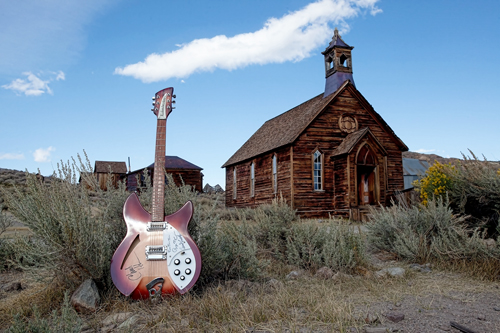 One of the more chaotic shoots was the “Turn, Turn, Turn” shoot. If you don’t know the story of the song “Turn, Turn, Turn,” by the Byrds, it’s a must! The lyrics come straight from the Bible. Stephen had a 1995 Rickenbacker 330 that was signed by the band. We wanted an abandoned church as the background to help tell the story. The church that spoke to us was in Bodie State History Park in Bodie, California. It’s an abandoned gold mine and often referred to as one of the top 10 abandoned places in the world. I landed in Reno and was planning on driving the next day to the park which was two hours away in the Sierra Nevada’s. While debarking the plane, I heard a weather forecast and there was a blizzard coming in that night. I knew my window to get the shot was closing. So I called the park and confirmed it was closing at 4:30 pm. I ran to get a rental car, grabbed my luggage, my camera gear, the guitar, and made the 133 mile route in under 2 hours! I arrived at the park at 4:00 pm, got the shot, walked around the park for 15 minutes, and then drove back to Reno where I spent the next two days hanging out in the casino.
One of the more chaotic shoots was the “Turn, Turn, Turn” shoot. If you don’t know the story of the song “Turn, Turn, Turn,” by the Byrds, it’s a must! The lyrics come straight from the Bible. Stephen had a 1995 Rickenbacker 330 that was signed by the band. We wanted an abandoned church as the background to help tell the story. The church that spoke to us was in Bodie State History Park in Bodie, California. It’s an abandoned gold mine and often referred to as one of the top 10 abandoned places in the world. I landed in Reno and was planning on driving the next day to the park which was two hours away in the Sierra Nevada’s. While debarking the plane, I heard a weather forecast and there was a blizzard coming in that night. I knew my window to get the shot was closing. So I called the park and confirmed it was closing at 4:30 pm. I ran to get a rental car, grabbed my luggage, my camera gear, the guitar, and made the 133 mile route in under 2 hours! I arrived at the park at 4:00 pm, got the shot, walked around the park for 15 minutes, and then drove back to Reno where I spent the next two days hanging out in the casino.
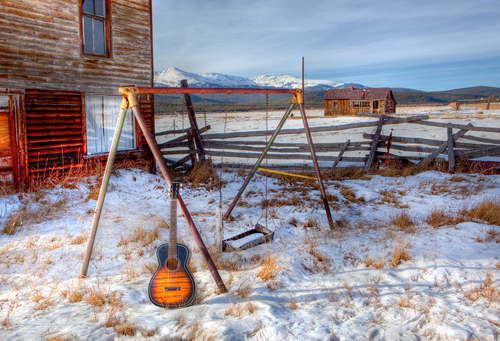 One of the images we captured was of Stephens very first guitar, a 1959 Sears Silvertone Acoustic. His parents purchased the guitar in 1959 for $14.99 from the Sears catalog. The perfect background for this image was an abandoned, rusty swing set just outside Leadville, Colorado. To this day it blows me away that Stephen still has the very first guitar he ever owned.
One of the images we captured was of Stephens very first guitar, a 1959 Sears Silvertone Acoustic. His parents purchased the guitar in 1959 for $14.99 from the Sears catalog. The perfect background for this image was an abandoned, rusty swing set just outside Leadville, Colorado. To this day it blows me away that Stephen still has the very first guitar he ever owned.
One of the coolest guitars I shot was an 1854 Schmidt and Maul. On the inside of the guitar was the signature of the luthier, Lous Schmidt. The signature included the date and address of where the guitar was made: 388 Broadway, New Your, New York. Legend has it that Louis Schmidt was one of the first luthiers that C.F. Martin used to build his guitars. The story goes that Mr. Schmidt built his own guitars and built guitars for Martin as well. Schmidt simply disappeared one day and was never to be heard from again. We knew we had to take this incredible piece of history back to it’s birth place. I traveled to New York, found the address. The location was under construction, the door was open and I could hear workers deep in the building. I walked in the door and propped the guitar up against the wall on the stairs and grabbed the shot. It’s one of those images that still gives me chills today.
The last story I’ll share is of a 1950 Martin D-28. Stephen had been commissioned by CNN to compose the music for a compelling series called “10 Years Later.” This was a series that would cover many aspects of 9/11. While dragging the guitar around the streets of New York, it occurred to me that the shot we needed was a New York Police Officer and Fireman holding the guitar with the new World Trade Center in the background. Today that is still one of the more surreal moments and images I’ve ever captured.
We ended up creating two books. The first one was a boutique book that Stephen gifted to network executives and art directors and the second was published and was available in book stores. Copies can still be found in half price book stores and other random places.
I could go on and on telling stories of shooting these guitars and helping a legend tell his stories through my images. Maybe one day I’ll write a book about it. This project changed my life… all because I had a simple idea to tell a story with my camera about someone’s passion.
I’m keeping my fingers crossed that we will do a version 2 of “A Story of Six Strings.” We actually shot a few guitars in the last few years and one of them, “Les Paul at Carnegie Hall,” was a merit image in 2020. It was signed by Les Paul and I photographed it at 4:00 am in New York outside Carnegie Hall.
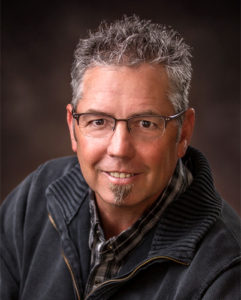 Chris Fritchie is a photographer and Texas School Instructor from McKinney Texas. He has over 10 years experience shooting editorial with over 125 magazine covers and thousands of published images. Learn more at: www.ChrisFritchieStudios.com.
Chris Fritchie is a photographer and Texas School Instructor from McKinney Texas. He has over 10 years experience shooting editorial with over 125 magazine covers and thousands of published images. Learn more at: www.ChrisFritchieStudios.com.



